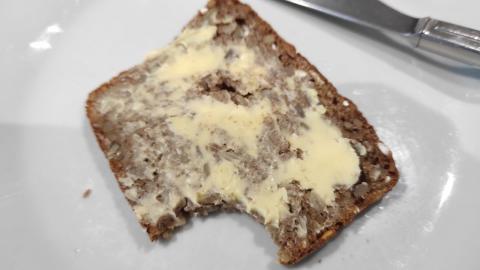
Foodgeek's Danish rye (rugbrød)

This bread ticks a whole bunch of health check-boxes for me and my ravenous teenager who is into healthy eating - whole grain, not wheat, and lots of fibre from seeds.
Foodgeek (Sune Trudslev) has a great description of this recipe with a matching video. He even has some fun suggestions of toppings you can use to make open sandwiches (smørrebrød) including, of course, smoked eel.
The high amount of seeds in this bread (90%) are what make it so special, bringing in some flavour, and a lot of chew and fibre. I prefer to use pumpkin seeds and rye kernels as per the original recipe, but practically it is not always possible to have enough seeds on hand and for this bake I'd run out so used a mix of seeds from the cupboard; this bread is still delicious with whatever is available.
There are variations of Danish rye, for example, this Stanley Ginsberg Danish rye recipe seems to only have about 20% in seeds, and possibly a more sour taste to it.
I take care when making this bread to keep the rye sponge fairly 'sweet' and I like to give it a final build 3-5 hours before using it in the final dough for this reason. The levain was made over 3 builds to achieve the 166% hydration sponge. Build 1 was 5g sweet stiff wheat starter:50g dark rye flour:50g water. Build 2 was the above:160g dark rye:160g water. Build 3 was the above:125g dark rye:344g water and 540g of this was used in the final dough when it was 3 hours old. Of course, there are lots of ways to make the levain and two alternatives are offered with the original recipe.
Sune's instructions for knowing when to bake is when the bread has risen 30-50% in the pan and there are 6-7 pinhead sized holes on top. I'd tend to agree with that, although for this bake the rye flour was super active and had reached the top of the pans after only 3 hours with many pinholes; consequently they were baked a little earlier than was usual and had some minor cracking on the top but otherwise I think the fermentation was spot on.
And, for this bake, inspired by Lance I tried painting on flour paste and starch washes to get some "glanz" on these breads, which sort of worked, they looked prettier than normal but I doubt you'd notice it unless you were looking carefully.
Besides the open sandwiches, this bread is great toasted and with a lot of butter. The Dane's have a special word for the tooth marks you leave behind when the butter is super thick, it is tandsmør ("tooth butter").
These breads are sweet and dense with a highly satisfying mouth feel, and I highly recommend this recipe if you love 100% rye or not.





Comments
A great looking loaf, Jon; it must be very tasty. That is an impressive amount of seeds - does the loaf structure hold together OK without being too crumbly?
I made a rugbrod a couple of months ago (recipe from Jacob Rosendahl ) that I was pleased with, though seeds were only about 25%.
Nice try with the starch coats, but with so many seeds, it's not surprising the effect was slightly diminished.
Lance
It is a little crumbly, but less so than for other 100% ryes that I've made as I think the seeds give it some sort of bendiness.
Looks great! I made the Danish Rye from Ginsberg's website and was indeed very sour. I actually didn't like it as much as I thought I would. I'll have to try one that's on the sweeter side.
If you like seeded bread, you might want to try the Schwarzer Hamster. I haven't tried it yet, but it does have a lot of seeds.
What an interesting recipe, and yes I'll have to try it. I can't find the Plotzblog version anywhere (which I see Lance made) so I'm just trying to read and interpret the baking German from your link.
The "kochstuk" is the confusing part, it is made in addition to the seed soaker, and while at first I thought it was a tangzhong/roux now it seems to be like a porridge made with the rye and spelt kernels.
Jon, here is my bread log for the Ketex variant which I made last year, in case it helps:
https://drive.google.com/file/d/1udQ3meNwpHCZDP4QcxEbpNdB8VHJVQpK/view?usp=sharing
Lance
I see that the hamster bread has a sister bread called the gray mouse! It's got millet in it and recommended to wait 2 to 3 days before eating.
Jon, I love the density of the seeds in this loaf. I’m sure I’d love this. Well done.
Benny
Looks great!